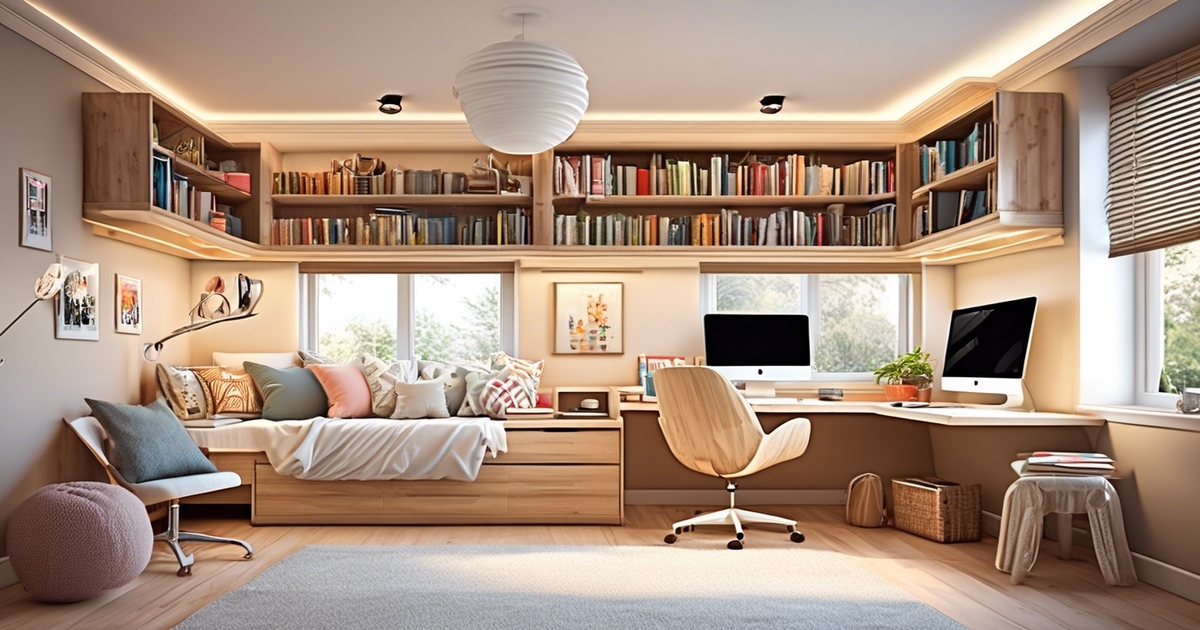How Big Should a Teenage Room Be: Designing the Ideal Space
Size matters. Creating a space that is both functional and comfortable for your teenager requires careful consideration of the room’s dimensions. The ideal room size can directly impact your teen’s mood, productivity, and overall well-being. In this post, we will delve into the essential factors to consider when determining how big a teenage room should be. From the influence of historical trends in interior design to modern-day spatial requirements for teenagers’ activities and privacy needs, and family, we’ll cover it all.
Key Takeaways
- Consider the Ideal Size: Aim for a teenage room size of at least 10 feet by 10 feet to provide ample space for various activities and furniture.
- Prioritize Functional Design: Factor in the teenager’s activities, hobbies, and personal style when designing the bedroom to create a space that reflects their individuality and supports their needs.
- Choose Appropriate Bed Sizes: Opt for a bed size that suits the teenager’s comfort and the room’s dimensions, such as a twin or full-size bed for most teenagers.
- Select Essential Furniture: Prioritize essential furniture pieces like a bed, study desk, storage solutions, and seating to maximize functionality in a limited space.
- Maximize Space Efficiency: Organize the room efficiently by utilizing vertical storage, multifunctional furniture, and smart layout designs to make the most of a compact teenage bedroom.
- Create a Teen-Friendly Environment: Design the room with the teenager’s preferences in mind, incorporating their favorite colors, decor elements, and personal touches to make it a comfortable and inviting space.
Ideal Teenage Room Size
Space Requirements
When designing a teenage room in the house, it’s crucial to consider the available space. The room should be spacious enough for various activities such as studying, relaxing, and spending time with friends. There should be adequate space for furniture like a bed, desk, wardrobe, and seating area. This ensures that the teenager can move around comfortably without feeling cramped.
For instance:
- A teenage room should have ample space for a study desk or computer table.
- It is essential to leave enough open floor space to accommodate movement and prevent clutter.
Average Dimensions
The standard dimensions for a teenage room typically range from 120 to 200 square feet. However, these measurements can vary based on location and housing type. In urban areas where real estate is limited, rooms may tend to be smaller compared to suburban or rural locations where larger homes are more common.
Consider this:
- In an urban apartment setting, a teenage room might average around 120 square feet due to spatial constraints.
- On the other hand, in a suburban home setting, teenagers may enjoy larger rooms averaging around 180–200 square feet.
Bedroom Size Regulations
Researching local building codes and regulations is vital when determining the appropriate size of a teenager’s bedroom. Different areas may have specific minimum requirements regarding bedroom dimensions. Some regions enforce legal restrictions on how small or large bedrooms can be in residential properties.
For example:
- Certain cities may mandate that each bedroom must have at least 70–80 square feet of floor area.
- Legal regulations could also stipulate ceiling height requirements that need to be met within bedrooms.
Factors in Designing Teen Bedrooms
Functional Space Planning
When designing a teenage room, it’s crucial to consider the different functional areas within the space. Think about creating zones for study, relaxation, and storage. For instance, a designated study area can be set up with a desk and proper lighting to facilitate focused studying. The relaxation zone could include comfortable seating or bean bags for unwinding after a long day.
Optimizing the layout is essential to accommodate various activities. This involves arranging furniture in such a way that it allows easy movement throughout the room while also ensuring each functional area serves its purpose effectively. By planning for these different functions, you can ensure that the teenage room provides an environment conducive to both productivity and relaxation.
Another vital aspect of functional space planning is storage. Incorporating ample storage solutions like shelves, drawers, and closets helps keep the room organized and clutter-free.
Comfort Considerations
When selecting furniture and decor for a teenage room, prioritizing comfort is key. Opt for cozy bedding options like soft comforters or duvets along with supportive mattresses or cushions on seating areas. Adequate ventilation plays an important role in maintaining comfort within the space as well.
Natural light not only brightens up the room but also contributes to creating an inviting atmosphere. Positioning furniture near windows can help maximize natural light exposure while incorporating curtains or blinds that allow flexibility in controlling light levels adds another layer of comfort.
Creating a cozy ambiance through decor choices is equally important when considering comfort considerations for teen bedrooms.
Aesthetic Zones
In addition to functionality and comfort, aesthetics play a significant role in enhancing the overall ambiance of a teenage bedroom. It’s essential to create visually appealing areas within the room by incorporating decorative elements into different zones.
For example:
- Adding wall art or posters can enhance visual appeal.
- Utilizing rugs or carpets can define specific zones within the room.
- Introducing accent pillows on seating areas adds pops of color and texture.
Bed Sizes for Teenagers
Single vs Double
There are several factors to consider. Single beds are space-efficient, leaving more room for other furniture like desks or dressers. They are also suitable for smaller rooms, providing ample floor space. On the other hand, double beds offer more sleeping area, ideal for growing teenagers who need extra space to stretch out and get a good night’s sleep.
For instance, if a teenager enjoys hosting sleepovers, a double bed can accommodate friends comfortably. However, in smaller rooms, a single bed might be the better choice as it allows more freedom of movement and creates an illusion of spaciousness.
In terms of preferences and sleeping habits, some teenagers may feel cozier in a single bed while others might appreciate the extra room offered by a double bed. It’s essential to take into account the individual needs and comfort of the teenager when deciding on the appropriate bed size.
Bed Placement
The placement of the bed within a teenage room is crucial in maximizing both functionality and aesthetics. When considering different options for bed placement, factors such as natural light exposure, access to power outlets for charging devices, and proximity to windows should be taken into account.
For example:
- Placing the bed near electrical outlets makes it convenient for charging phones or using bedside lamps.
- Positioning the bed away from direct sunlight can help regulate temperature during hot summer days.
- Opting for an arrangement that allows easy access to windows ensures proper ventilation and natural light exposure.
Optimizing bed placement involves creating enough open floor space around the bed which contributes to an uncluttered look while allowing ease of movement within the room. This is particularly important in small bedrooms where every inch counts.
By carefully considering these aspects when choosing between single or double beds as well as determining their optimal placement within a teenage bedroom can lead to creating an inviting and functional living space tailored specifically towards meeting their needs.
Essential Teenage Room Furniture
Storage Solutions
It’s crucial to maximize space. Utilize closets, shelves, and under-bed storage to keep the room organized. For instance, using bed risers can create extra space underneath for storage bins or drawers.
To maintain an organized room, consider incorporating creative solutions such as wall-mounted organizers and multi-functional furniture like ottomans with hidden storage. This not only maximizes space but also adds a stylish touch to the room.
Study Area Essentials
A dedicated study area is essential for teenagers to focus on their academic tasks effectively. Key elements of an effective study space include a spacious desk, comfortable chair, good lighting, and adequate storage for books and supplies.
Creating a conducive environment for studying involves minimizing distractions by positioning the study area away from high-traffic areas or noisy appliances. Adding personal touches like motivational posters or plants can enhance the ambiance of the study space.
Relaxation Furniture
For promoting downtime in a teenage room, comfortable seating is crucial. Options such as bean bags, lounge chairs, or cozy armchairs can provide ideal spots for relaxation and leisure activities like reading or listening to music.
Ergonomic considerations are vital when selecting relaxation furniture; prioritize options that offer proper support for posture during extended periods of sitting. This helps prevent discomfort and supports overall well-being in everyday use.
By emphasizing efficient storage solutions, creating conducive study areas, and prioritizing comfort through relaxation furniture choices, teenage rooms can become versatile spaces that cater to both productivity and leisure.
Organizing a Compact Teen Bedroom
There are several practical tips that can help create a more functional and spacious environment. One effective strategy is to maximize floor space by utilizing vertical storage solutions such as wall-mounted shelves or floating desks. These options free up valuable floor space while providing ample storage for books, decorations, or study materials.
Another important aspect of efficient use of space is the careful selection of furniture with built-in storage features. For example, choosing a bed frame with drawers underneath can eliminate the need for additional dressers or cabinets, thereby creating more open space within the room. Utilizing closet organizers and modular storage systems can help keep belongings organized and prevent clutter from encroaching on living areas.
In addition to these strategies, incorporating dual-purpose furniture items into the design of a teenage room can significantly contribute to maximizing available space. For instance, a futon sofa bed serves as both seating during the day and a sleeping area for guests at night. Similarly, an ottoman with hidden storage provides extra seating while also offering a place to stow away blankets or other items when not in use.
Designing a Teen-Friendly Space
Personalization is key. Incorporating decor and accessories that resonate with the teenager’s interests and hobbies can make the space feel uniquely theirs. For instance, if your son is passionate about sports, consider adding framed jerseys or sports-themed wall art to reflect his personality. On the other hand, if you have a daughter who loves music, integrating musical elements like vinyl records as wall decor or a themed area rug can add a personalized touch.
Reflecting the teenager’s personality through design choices helps create a sense of ownership and belonging in their space. It also fosters creativity and self-expression, which are crucial aspects of adolescent development. Encourage them to display items that represent their individuality – whether it’s artwork they’ve created themselves, photographs with friends, or souvenirs from memorable experiences. By doing so, you’re not only creating an aesthetically pleasing room but also nurturing their sense of identity.
Selecting suitable color schemes for teenage rooms involves considering the impact of colors on mood and ambiance while catering to personal preferences. Soft pastel hues such as pale blue or lavender can evoke tranquility and relaxation – ideal for promoting restful sleep in a bedroom setting. Conversely, vibrant colors like energetic reds or cheerful yellows can infuse energy into study areas or creative spaces within the room.
When choosing color palettes for teenage rooms, aim for cohesion by selecting complementary shades that tie the overall look together cohesively without overwhelming the space visually. For example, pairing neutral walls with pops of color through accent pillows or decorative accents can strike a balance between vibrancy and sophistication while allowing easy updates as tastes evolve over time.
Considering these factors when exploring different color schemes ensures that the room reflects both your teen’s preferences and creates an environment conducive to their well-being.
Planning the Bedroom Layout
Activity Zones
When planning a teenage room, it’s crucial to identify distinct activity zones. These could include study, relaxation, and dressing areas. To delineate these zones effectively within the space, consider using furniture or room dividers. For instance, you can place a desk and bookshelf in one area for studying and designate another corner for a cozy reading nook with a bean bag chair or floor cushions.
To create an effective study zone within the room, position the desk near a natural light source such as a window to provide ample lighting for reading and writing. Consider incorporating storage solutions like shelves or drawers to keep books and school supplies organized.Placing comfortable seating options like an armchair or lounge chair can define this space as suitable for winding down after a long day.
Ensuring Adequate Furniture Space
Clearance Guidelines Highlight recommended clearance around furniture and fixtures
It’s crucial to ensure there is enough space for movement. For instance, the area around the bed should have at least 24 inches of clearance for comfortable access. This allows for easy bed-making and prevents a cramped feeling in the room. Similarly, leaving about 36 inches of clear space in front of dressers or wardrobes ensures convenient opening and closing of drawers or doors without any obstructions.
Considering safety aspects is essential when setting up clearances. Keeping electrical outlets accessible by maintaining a minimum distance from furniture helps prevent potential hazards such as fire risks due to overheating caused by blocked vents or cords trapped behind heavy pieces. Moreover, ensuring that windows remain unobstructed not only maintains an open feel but also serves as an important safety feature during emergencies like fires or earthquakes.
Furniture Scaling Provide guidance on selecting appropriately scaled furniture for a teenage room
Selecting appropriately scaled furniture plays a significant role in creating both visual balance and functionality within a teenage room. Large-sized beds or bulky dressers can overwhelm the limited space available, making the room appear crowded and smaller than it actually is. On the other hand, choosing compact yet functional pieces can maximize floor area while still providing ample storage solutions.
For example, opting for a twin-size bed instead of a full-size one leaves plenty of extra floor space for other essential items such as study desks or seating arrangements without compromising comfort during sleep. Multi-functional furniture like loft beds with built-in desks or storage units can efficiently utilize vertical space while offering versatile usage options suitable for various activities such as studying, relaxing, and organizing belongings.
Meeting Building Codes for Bedrooms
Safety Standards Emphasize adherence to safety standards when designing a teenage room
It’s crucial to consider furniture arrangement to allow for easy movement and prevent accidents. For instance, leaving enough space around the bed and other furniture can reduce the risk of tripping or bumping into objects. Securing heavy furniture like bookshelves and dressers to the wall can prevent them from tipping over.
Furthermore, ensuring that electrical outlets are not overloaded is essential for preventing fire hazards. Placing power strips strategically and avoiding daisy-chaining multiple extension cords can help maintain electrical safety in the room. Moreover, window treatments should be cordless or have inaccessible cords to eliminate potential strangulation hazards.
Furniture: By placing furniture such as beds, desks, and chairs thoughtfully within the room’s layout, teenagers can move around safely without obstructions. Electrical Outlets: Ensuring that electrical outlets are not overwhelmed with too many devices plugged into one socket reduces the risk of overheating or electrical fires. Window Treatments: Choosing cordless or inaccessible-cord window treatments prevents potential dangers related to entanglement.
Legal Size Requirements Summarize legal size requirements applicable to teenage bedrooms based on local regulations
In terms of legal size requirements, local building codes may specify minimum dimensions for a bedroom intended for use by teenagers. These regulations typically outline specific square footage measurements aimed at ensuring adequate living space within each bedroom.
For example, some jurisdictions may require that a teenage bedroom must be at least 70 square feet in area with no dimension less than 7 feet in any horizontal direction. Adhering to these legal size requirements ensures that teenagers have sufficient space for their activities while also meeting established safety standards.
Local Regulations: Local building codes often stipulate minimum dimensions for a teenager’s bedroom; adhering to these ensures compliance with legal size requirements. Square Footage Measurements: Some jurisdictions mandate a minimum area of 70 square feet with no dimension less than 7 feet horizontally.
Closing Thoughts
You’ve now got the lowdown on crafting the perfect teenage room. Remember, it’s not just about the size; it’s how you use it. From nifty furniture to savvy layouts, there are tons of ways to make the most of any space. So, whether your teen’s room is as snug as a bug in a rug or spacious enough to roller-skate in, these tips can help create a cool and functional haven for them.
Now it’s time to put these ideas into action and transform that room into a place your teenager will love. Get them involved in the process and let their personality shine through in the design. With some creativity and a dash of practicality, you can turn their room into the ultimate hangout spot they’ll never want to leave!
Frequently Asked Questions
How do I determine the ideal size for a teenage room?
To determine the ideal size for a teenage room, consider allowing at least 70 square feet of space. This should provide ample room for essential furniture and activities while ensuring a comfortable environment.
What factors should I consider when designing a teen bedroom?
When designing a teen bedroom, factors to consider include the teenager’s personal preferences, storage needs, study area requirements, and space utilization. It’s important to create a functional and personalized space that reflects their individuality.
What are the recommended bed sizes for teenagers?
For most teenagers, twin or full-size beds are suitable options as they offer adequate sleeping space without overwhelming the room. Consider the available space in the room and your teenager’s comfort preferences when choosing an appropriate bed size.
What essential furniture items should be included in a teenage room?
Essential furniture items for a teenage room typically include a bed, desk or study area, storage solutions such as dressers or shelves, seating options like chairs or bean bags, and possibly additional decorative elements to reflect their personality.
How can I effectively organize a compact teen bedroom?
To effectively organize a compact teen bedroom, utilize multi-functional furniture pieces like loft beds with built-in desks or storage compartments. Maximize vertical wall space with shelving units and opt for foldable or stackable items to save floor space.







